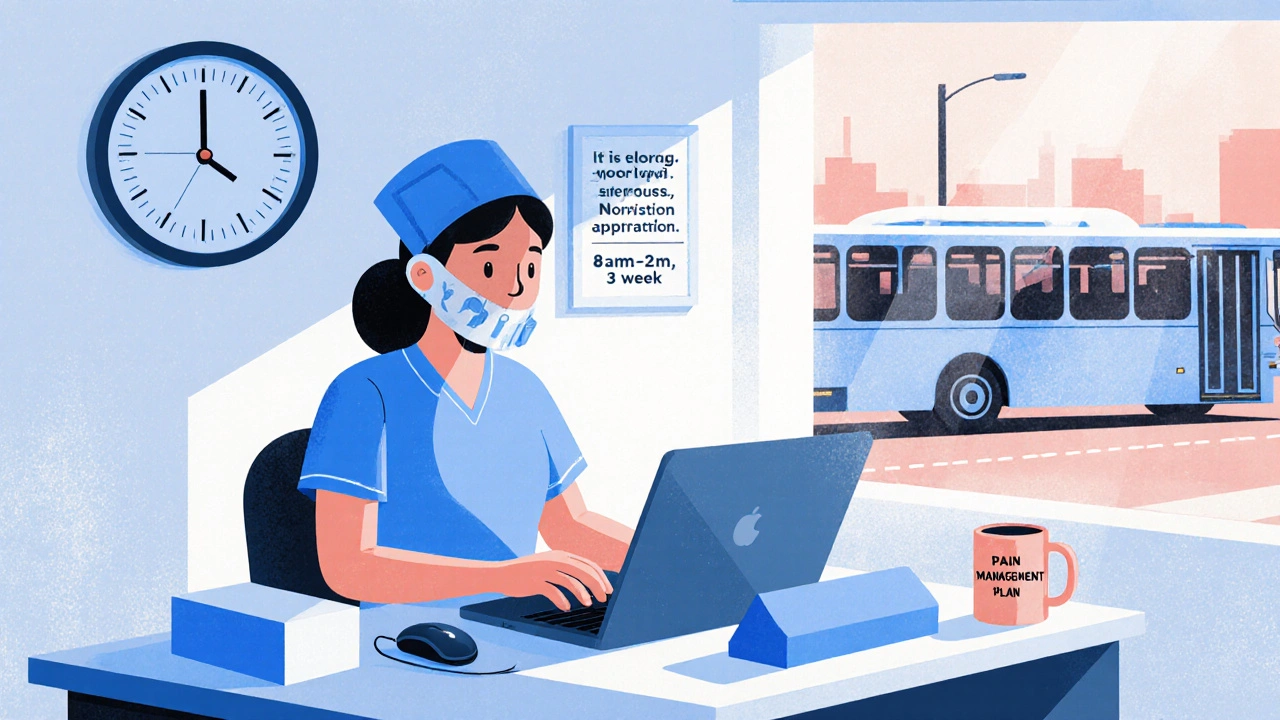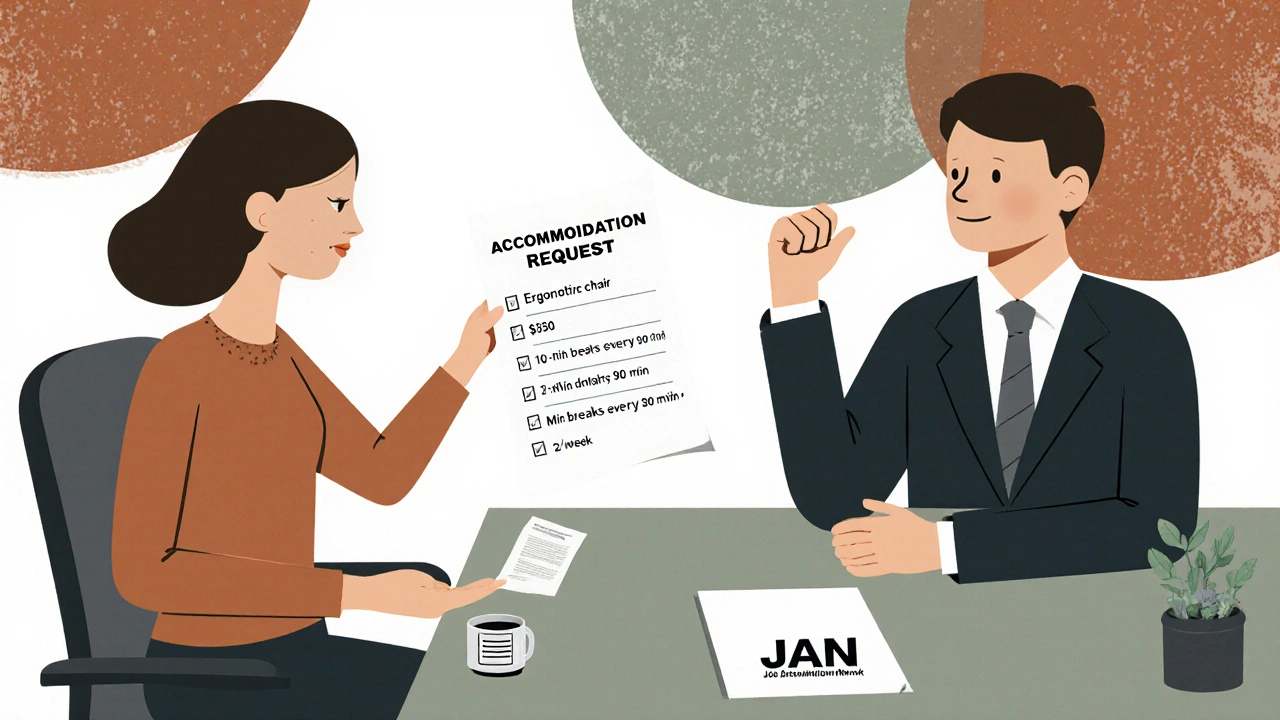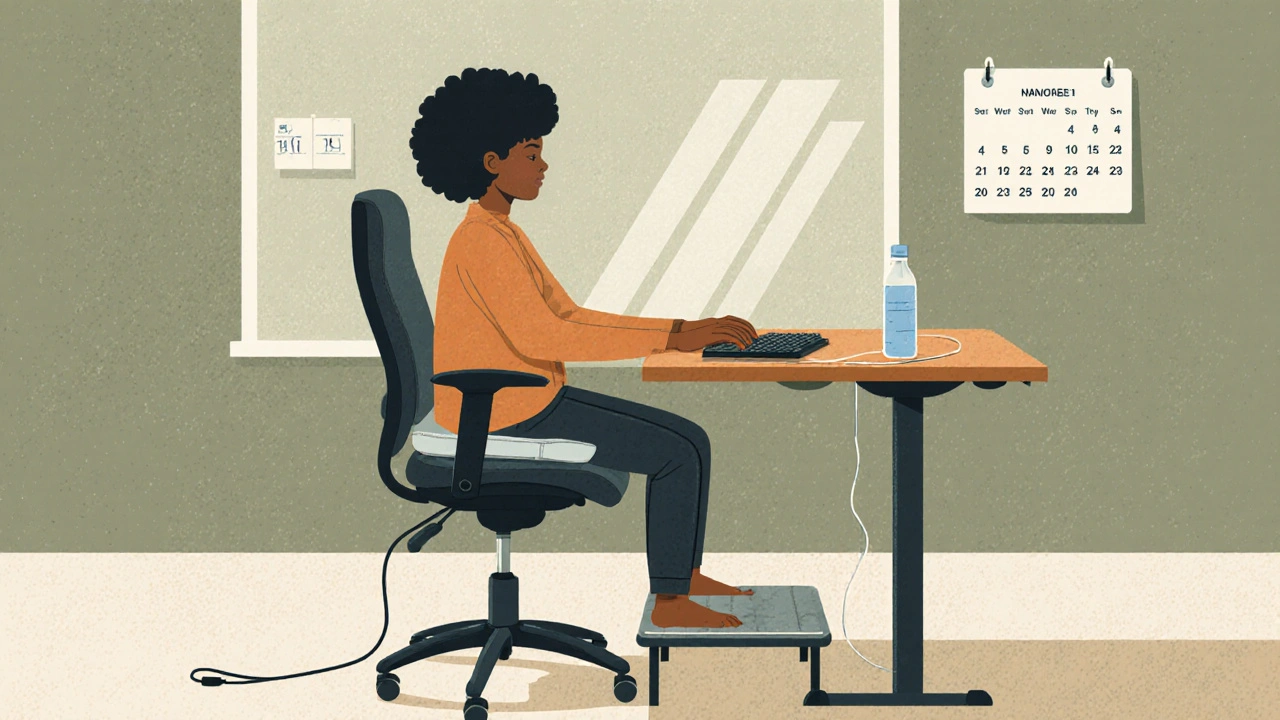Returning to work with chronic pain is possible - if you know how to ask for the right support
Over 50 million adults in the U.S. live with chronic pain - that’s more than 1 in 5 people. Many of them want to keep working, but don’t know how to make it happen without making things worse. The truth is, you don’t have to choose between your health and your job. The law protects you. Employers are required to make reasonable changes so you can do your job. But knowing what to ask for - and how to ask for it - makes all the difference.
Chronic pain isn’t just a bad day. It’s pain that lasts longer than three months and interferes with your ability to sit, stand, walk, lift, or focus. Under the Americans with Disabilities Act (ADA), this qualifies as a disability if it limits major life activities. That means your employer must work with you to find solutions - not push you out. But here’s the catch: most people don’t get accommodations because they don’t ask clearly, or they wait too long.
What accommodations actually work for chronic pain?
Accommodations aren’t luxury perks. They’re practical, low-cost adjustments that let you do your job without worsening your pain. The Job Accommodation Network found that 56% of accommodations for chronic pain cost nothing at all. The rest? The median cost is just $300 - less than a new laptop.
- Ergonomic chairs and desks: If sitting for long periods hurts your back or hips, an adjustable standing desk (around $300-$1,200) lets you alternate between sitting and standing. Pair it with an ergonomic chair ($200-$1,000) that supports your spine.
- Specialized keyboards and mice: Repetitive motion can flare up arthritis or tendonitis. A vertical mouse or split keyboard reduces strain on wrists and shoulders. These cost between $50 and $300.
- Footrests and seating cushions: A simple footrest ($25-$150) improves posture. A memory foam cushion ($50-$200) can ease pressure on the tailbone or sciatic nerve.
- Voice recognition software: If typing is painful, tools like Dragon NaturallySpeaking ($100-$300) let you dictate emails and documents without using your hands.
- Temperature control: For people with conditions like multiple sclerosis or fibromyalgia, heat or cold can make pain worse. Request access to a personal heater or fan. Move your desk away from drafty windows or heating vents.
One person I know with severe lower back pain asked for a heated massage cushion that plugs into a standard outlet. It cost $85. Her employer approved it in two days. She didn’t ask for "pain relief." She named the exact item, its price, and how it helped her sit through meetings.
Flexible hours and remote work aren’t privileges - they’re tools
Chronic pain doesn’t follow a 9-to-5 schedule. Some days, you’re fine. Other days, even getting out of bed is hard. That’s why flexibility matters.
- Flexible start and end times: If you need to go to physical therapy at 10 a.m., ask to start at 11 a.m. and work later. Most jobs can adjust by an hour or two.
- Extra breaks: Taking a 10-minute break every 90 minutes to stretch, walk, or lie down can prevent pain spikes. You’re not being lazy - you’re preventing burnout.
- Telecommuting: Working from home even one or two days a week removes the stress of commuting, standing in line at the coffee machine, or navigating a noisy office. You don’t need to work from home full-time to benefit.
- Modified work hours: If you’re on a 40-hour schedule but can only handle 25 hours a week, ask for a temporary reduced schedule. Gradual return-to-work plans (starting at 20-50% hours) have a 63% higher long-term success rate than jumping back to full-time.
One nurse with chronic migraines started working 8 a.m. to 2 p.m. three days a week. She didn’t lose her benefits. She didn’t lose her seniority. She just worked fewer hours - and stayed employed. Her employer didn’t lose productivity; they just changed how the work was scheduled.
How to ask for accommodations - without sounding demanding
The biggest mistake people make? Asking vaguely. Saying "I need help with my pain" gets ignored. Saying "I need a sit-stand desk and 10-minute breaks every 90 minutes to manage my lower back pain" gets approved.
Here’s how to do it right:
- Get documentation from your doctor. Not just "patient has chronic pain." They need to say: "This patient has degenerative disc disease. Sitting for more than 60 minutes causes severe pain and muscle spasms. Recommended accommodations: adjustable desk, 10-minute breaks every 90 minutes, and ability to work remotely up to two days per week."
- Put it in writing. Email your manager and HR. Say: "Per the ADA, I am requesting reasonable accommodations to continue performing my job duties. Attached is documentation from my provider. I’d appreciate a meeting to discuss how we can implement these changes."
- Be specific about cost and function. Don’t say "I need a better chair." Say: "I need an ergonomic chair with lumbar support that costs $750. It will allow me to sit for 4 hours without pain, reducing missed workdays."
- Offer to help find solutions. Say: "I’ve looked into options and found a chair that meets our budget. I’m happy to help coordinate delivery."
People who use this method get approved 89% of the time. Those who say "I’m having trouble" get denied 60% of the time.

What if your employer says no?
Employers can refuse accommodations only if they prove it causes "undue hardship" - meaning it’s too expensive or disruptive for their size. For a small business with 10 employees, $500 might be undue hardship. For a company with 500 employees? Not likely.
Here’s what to do if you’re denied:
- Ask for the reason in writing. They must explain why it’s a hardship.
- Propose alternatives. If they say a standing desk is too expensive, suggest a foam mat ($40) and scheduled walking breaks.
- Contact the Job Accommodation Network (JAN). They’re free, confidential, and help both employees and employers. They’ve resolved 82% of cases without formal complaints.
- File a complaint with the EEOC. You have 180 days from the date of denial. The EEOC handles over 17,000 ADA complaints a year - and most are settled before court.
Don’t assume your boss is being mean. Most don’t know the law. They just don’t know what to do. Your job is to show them the path.
The hidden factor: your coworkers and supervisors matter more than you think
Research shows that employees with strong relationships at work are 2.3 times more likely to get accommodations approved. Why? Because when your manager sees you as a person - not a problem - they’re more willing to help.
Build that trust by:
- Being open about your limits without oversharing. Say: "I’m managing a health issue, and these changes help me stay productive. I appreciate your support."
- Keeping your work quality high. If you’re reliable, people are more likely to accommodate you.
- Asking for help with tasks that are physically hard - like lifting boxes or carrying files. Offer to trade tasks with someone else. Most people are happy to help.
One warehouse worker with chronic knee pain asked his team to rotate the heavy lifting duties. No one complained. They just saw someone who showed up every day and did their part. That’s the kind of respect that opens doors.
What about leave? Can I take time off?
The Family and Medical Leave Act (FMLA) gives you up to 12 weeks of unpaid, job-protected leave if you’ve worked 1,250 hours in the past year and your employer has 50+ employees within 75 miles. But FMLA doesn’t give you accommodations. It just buys you time.
Use FMLA when you need to recover from a flare-up, have surgery, or start a new treatment. But don’t wait until you’re completely burned out. Start the accommodation process early - even if you’re still working. The goal is to avoid needing leave in the first place.
Some states go further. In California, employers with just 5 employees must provide accommodations. In New York, you can get paid leave through state disability insurance. Know your state’s rules.

What’s changing in 2025?
Chronic pain is no longer ignored. The Department of Labor launched the "Return to Work Initiative" in early 2023, funding state programs to create standardized accommodation guides. More employers are using wearable tech to track movement and fatigue - not to spy on you, but to help design better schedules.
Long COVID-related pain is now clearly protected under the ADA. If your pain started after a virus and lasts more than three months, you’re covered. That’s a big shift - and it’s helping thousands.
Legislation is also moving to expand FMLA to smaller businesses. That could change everything for people working at shops, restaurants, or small offices.
You’re not broken. You’re adapting.
Chronic pain doesn’t mean the end of your career. It means you need to work differently. And that’s okay. The best workplaces aren’t the ones that ignore pain - they’re the ones that learn how to support it.
Start today. Talk to your doctor. Write down your needs. Send that email. You’re not asking for special treatment. You’re asking for the right to do your job - without hurting yourself.
And if you’re an employer reading this? The cost of losing a good employee is far higher than the cost of a $300 desk or a few flexible hours. The best talent stays when they feel seen.
Frequently Asked Questions
Can my employer fire me for having chronic pain?
No. Under the ADA, it’s illegal to fire someone because of a disability, including chronic pain, if they can perform the essential functions of their job with reasonable accommodations. Employers can’t terminate you just because you have pain - only if you can’t do your job even with adjustments, and even then, they must prove they tried everything possible.
Do I have to tell my boss I have chronic pain?
You don’t have to disclose your diagnosis, but you do need to explain your functional limitations if you want accommodations. You can say: "I have a medical condition that affects my ability to sit for long periods," without saying "I have fibromyalgia." Your doctor’s note will cover the diagnosis. You control what’s shared.
What if I work for a small company with fewer than 15 employees?
The ADA doesn’t apply to companies with fewer than 15 employees. But some states, like California and New York, require accommodations for employers with 5 or more workers. Even if you’re not legally protected, it’s still worth asking. Many small businesses are happy to make low-cost changes to keep good employees.
Can I ask for accommodations even if I’m not on leave?
Yes. In fact, you should. Waiting until you’re too sick to work makes things harder. The best time to request accommodations is when you’re still working - even if you’re struggling. This prevents burnout and keeps you employed. Employers are more likely to help when you’re still contributing.
How long does it take to get accommodations approved?
Federal agencies must respond within 10 business days. Private employers have no legal deadline, but they must respond "promptly" under the ADA. If you haven’t heard back in two weeks, follow up in writing. If you’re still ignored after 30 days, contact the Job Accommodation Network for help.
Are there free resources to help me request accommodations?
Yes. The Job Accommodation Network (JAN) offers free, confidential guidance for employees and employers. They provide sample letters, accommodation ideas, and legal advice. You can call them or visit their website - no cost, no strings attached. They’ve helped over 100,000 people since 2020.


Bartholemy Tuite
man i wish i had this guide when i was stuck in that soul-sucking call center job with my sciatica
i just kept saying "i’m tired" and they thought i was lazy
turns out all i needed was a footrest and permission to walk around during breaks
cost me $35 and saved my career
also, the guy who sat next to me started using a standing desk after seeing mine
now we both work 4 days a week and no one even noticed the change
people think accommodations are weird but they’re just common sense with a paperwork label
and yeah, irish here - we don’t do "disability" talk much but we do "get on with it"
so if you’re reading this and you’re hurting - ask for the damn footrest
your boss isn’t a villain, they’re just clueless
give them the script, not the sob story
and if they say no? send them to JAN. free. no bs.
also, i once asked for a heater under my desk. they gave me a space heater. i didn’t complain.
win-win.